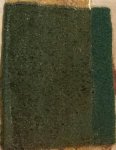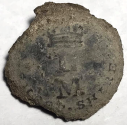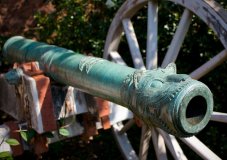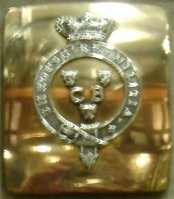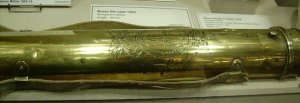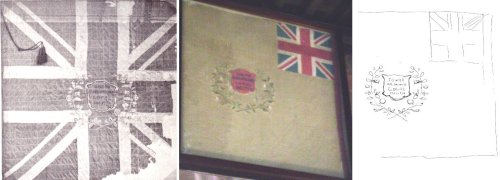This page sets out what information I have on the Shropshire Local Militia in general and individually for the five regiments raised in 1808, the Northern, Western, Central, Southern and Wrekin regiments. It is certainly not complete, and will be revised as new information arrives.
Reference is made throughout to Howard Ripley and Bob Moodie, Local Militia Buttons, 1994 and 2002.
Click all images to enlarge.
General observations
The county’s volunteer infantry corps of 1803 had largely adhered to the colours of their county militia, but the dress of the new regiments was intended to be completely uniform:
The clothing of the Local Militia is to be the same in every respect as that worn by the regular militia of the county.
The pattern was that of the single existing regiment of Shropshire Militia, with dark green facings. (The 2nd Regiment, differently uniformed, had been disbanded in 1805.) Evidence is clear that at the time of the formation of the Local Militia the officers’ coats of the “regular” regiment had button holes in pairs without lace, with the top and front of the collar, lapels and tops of the cuffs all edged narrowly in white, a button and twist hole at each side of the collar. The white turnbacks were not edged, and the officers’ metal colour was gold. A sample attached to the Buckmaster tailor’s book at the National Army Museum (thanks to Ben Townsend for an image of this) shows the green to have been a dark, dull shade, but not blackish. We can assume that the officers’ dress of the Local Militia regiments would have conformed to this pattern – see below under the South Regiment.
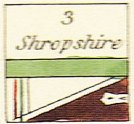
Hamilton Smith, showing the later form of loop, a rather pale green, and (wrongly?) silver lace for officers
The men’s jackets of the Shropshire Militia were supplied by the firm of Dolan’s, for whom no notebooks survive with details, but it is certain that, in conformity with the dress of the officers, these would have been buttoned and looped in pairs, the loops probably square ended. The lace, at least as shown in 1815 by the Hamilton Smith chart, had one red and one green stripe, the green towards the outside of the loop. The men’s jackets of the
Local Militia would have conformed to this pattern.
(There is archival evidence that a new form of loop was introduced to the Shropshire “regular” Militia with the clothing of 1811, and the later Hamilton Smith chart shows this to have been “bastion” shaped, single spaced. It’s not clear whether the Local Militia regiments would have followed this change at their re-clothing. Hamilton Smith also shows the “regular” officer’s lace in 1815 as silver, but there seems to be no supporting evidence for this.)
North Shropshire Local Militia (Shrewsbury)
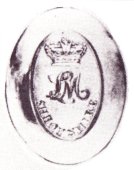 Col Comm John Kynaston Powell. Powell’s commission as colonel dated from 1797, when he had commanded the Shropshire Supplementary Militia; subsequently he commanded the 18 company regiment of Shropshire Volunteers, to whom the North and West Local Militia, both formed in 1808, were the successors.
Col Comm John Kynaston Powell. Powell’s commission as colonel dated from 1797, when he had commanded the Shropshire Supplementary Militia; subsequently he commanded the 18 company regiment of Shropshire Volunteers, to whom the North and West Local Militia, both formed in 1808, were the successors.
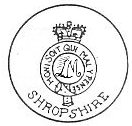 Vol IV of The History of the Corps of the King’s Shropshire Light Infantry (1970), compiled by G Archer Parfitt, shows an officer’s belt plate, identified only as Local Militia, but in the exact style of that of the regiment of Shropshire Volunteers. Within a broad border, it bears a crown over script “LM” and “Shropshire” in serifed capitals. This would have been gilt.
Vol IV of The History of the Corps of the King’s Shropshire Light Infantry (1970), compiled by G Archer Parfitt, shows an officer’s belt plate, identified only as Local Militia, but in the exact style of that of the regiment of Shropshire Volunteers. Within a broad border, it bears a crown over script “LM” and “Shropshire” in serifed capitals. This would have been gilt.
In the Shropshire Regimental Museum at Shrewsbury Castle is an unattributed button of a design that matches this plate, showing a crowned garter inscribed “Honi Soit” etc, enclosing script “LM”, all above “Shropshire” in serifed capitals. The button is gilt and convex. (It is not shown by Ripley
and Moodie.)
A likely button of a different design has been excavated in the USA, presumably from the jacket of a militiaman who volunteered for the line., and is shown here courtesy of its owner, Brian Harpring Savannah Harps. The design is a crown over “L/M” over “SHROP.SHIRE”, apparently with a stop after the P, unusually. This is a reprise of the button design of the Shropshire Volunteers of 1803, the predecessor to the North and West Local Militia, which used a “V” in place of “LM”.
West Shropshire Local Militia (Shrewsbury)
Col Comm John Kynaston Powell. Powell’s commission as colonel dated from 1797, when he had commanded the Shropshire Supplementary Militia; subsequently he commanded the 18 company regiment of Shropshire Volunteers, to whom the North and West Local Militia, both formed in 1808, were the successors.
The plate and buttons shown above are equally attributable to this regiment, as part of a joint command.
An Artillery Corps was attached to the West Regiment; it had formerly been part of Kynaston Powell’s Shropshire Volunteers. It had been created in July 1805, and was armed with two tiger-headed bronze three pounders captured among the ordnance of Tipu Sultan captured at Seringapatam in 1799, and loaned to the regiment by Lord Clive. In October 1805 these guns were fitted with “proper Harness” and shafts, and painted a pale artillery grey. They are now at Powis Castle, and are documented in this post. Willson’s chart of 1806 gives the dress of the Artillery Corps as, predictably, blue faced red with white legwear, the officers’ lace gold, and there is no reason to doubt that this would have remained substantially the same under the Local Militia regime.
Centre Shropshire Local Militia (Shrewsbury)
Col Comm Richard Lyster, commissioned 24 September 1808. The regiment was termed both a “regiment” and a “battalion”.
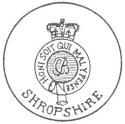 Ripley and Moodie show a drawing of a gilt, domed button showing a crowned garter inscribed “Honi Soit” etc, surrounding “CB” in script for “Centre Battalion”, above “Shropshire” in serifed capitals.
Ripley and Moodie show a drawing of a gilt, domed button showing a crowned garter inscribed “Honi Soit” etc, surrounding “CB” in script for “Centre Battalion”, above “Shropshire” in serifed capitals.
In the Shropshire Regimental Museum is an officer’s belt plate, inscribed “C B”. This is interpreted in the display as standing for “Countess of Bath”, but is clearly for “Centre Battalion”. The rectangular gilt plate with rounded corners bears an applied crowned garter inscribed “Shropshire ● Militia”, enclosing the three leopards’ heads (“loggerheads”) of the county’s arms and “C B” in serifed capitals, all applied in silver on the gilt ground. It is illustrated and described by G Archer Parfitt in the MHS Bulletin 68 of May 1967, and in Vol IV of The History of the Corps of the King’s Shropshire Light Infantry (1970).
The same design, over two sprays of laurel(?) leaves, is engraved on a brass fife case in the Regimental Museum, wrongly dated to 1803 in the display.
An Orderly Book of 1810-12 (photocopy in Shropshire Archives, 6005/SHYTA/1209) notes in October 1811: “The Men to be in Breeches and Leggings” on morning and
evening parades, suggesting that trousers
or pantaloons may have been worn in other
orders of dress.
South Shropshire Local Militia (Ludlow)
Col Edward, Earl of Powis, commissioned 25 April 1809.
In the National Army Museum is a battalion officer’s coat. I have not seen this but in Vol V of C C P Lawson’s A History of the Uniforms of the British Army (1967), it is briefly described as faced in green, the collar, cuff and lapel edges piped in white.
 In the Gaunt collection at Birmingham Museum is a gilt, convex button, showing in relief “South Shropshire”, in serifed capitals separated by stars, within dotted borders, enclosing a crown above “L ● M” in serifed capitals. Another example is at the Shropshire Regimental Museum. These match the drawing by Ripley and Moodie, where the sizes are given as 19 mm and 13.5 mm in diameter.
In the Gaunt collection at Birmingham Museum is a gilt, convex button, showing in relief “South Shropshire”, in serifed capitals separated by stars, within dotted borders, enclosing a crown above “L ● M” in serifed capitals. Another example is at the Shropshire Regimental Museum. These match the drawing by Ripley and Moodie, where the sizes are given as 19 mm and 13.5 mm in diameter.
A note in Vol IV of Parfitt’s The History of the Corps of the King’s Shropshire Light Infantry (1970) states that the officer’s belt plate was oval, gilt, showing the regimental title in full (on a garter?) beneath a crown, and enclosing the Royal cypher “GR”. I have not seen such a plate.
The silk colours are in the keeping of the Shropshire Regimental Museum at Shrewsbury Castle, and are shown in black and white in Parfitt’s History. One or both had been until 1962 at Powis Castle, the home of the Colonel and Lord Lieutenant, Edward, Earl of Powis.
The King’s colour is described by Parfitt as silk, the title “South / Shropshire / Local / Militia” embroidered in silver on a red shield edged in gold, surrounded by a Union wreath of roses, thistles and shamrocks. (The equivalent lettering on the regimental colour appears black.) The roses in the wreath are white. The sleeve for the staff is red or crimson. The silk cords and tassels are described as crimson and gold mixed.
The regimental colour is not mentioned by Parfitt, but is on display at the Shropshire Regimental Museum, though its location makes detailed viewing difficult. The field must have been green, though it now appears a yellowish buff. The sleeve for the staff is red or crimson. At the centre is a red shield, now a shade of crimson, edged in gold, inscribed in serifed capitals “South / Shropshire / Local / Militia”. The lettering may once have been silver, as described for the King’s colour, but now appears black. Around the shield is a Union wreath, mostly green, with white roses and with thistles and shamrocks. The cords and tassels are not visible but must match those of the King’s colour.
Wrekin Local Militia (Wellington)
Lieut Col Comm Thomas Eyton, commissioned 24 December 1808.
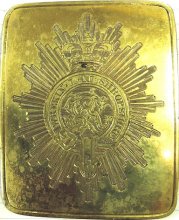 The Gaunt collection at Birmingham Museum and the Shropshire Regimental Museum both hold examples of an other ranks’ belt plate; this is rectangular, of brass, with the recessed design of an eight rayed star bearing a crowned garter inscribed in serifed capitals “Wrekin ● L ● M ● Shropshire”, enclosing an ornate “GR” Royal cypher. This is illustrated and described by G Archer Parfitt in the MHS Bulletin 68 of May 1967, and in Vol IV of The History of the Corps of the King’s Shropshire Light Infantry (1970).
The Gaunt collection at Birmingham Museum and the Shropshire Regimental Museum both hold examples of an other ranks’ belt plate; this is rectangular, of brass, with the recessed design of an eight rayed star bearing a crowned garter inscribed in serifed capitals “Wrekin ● L ● M ● Shropshire”, enclosing an ornate “GR” Royal cypher. This is illustrated and described by G Archer Parfitt in the MHS Bulletin 68 of May 1967, and in Vol IV of The History of the Corps of the King’s Shropshire Light Infantry (1970).
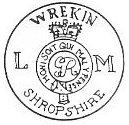 In these sources Parfitt also mentions an officer’s plate “similar … but in copper gilt” and a cap plate of the 1812 pattern, in 1967 in the possession of J V Webb. These have not turned up in the 2020 sale by DNW of the Jack Webb collection, which does include a gilt copper gorget, identified to Lieut R H Gwynn. Most unusually for this date, the design is corps-specific, and repeats that of the plate. The ribbons and rosettes now appear dark blue, but would have been originally dark green.
In these sources Parfitt also mentions an officer’s plate “similar … but in copper gilt” and a cap plate of the 1812 pattern, in 1967 in the possession of J V Webb. These have not turned up in the 2020 sale by DNW of the Jack Webb collection, which does include a gilt copper gorget, identified to Lieut R H Gwynn. Most unusually for this date, the design is corps-specific, and repeats that of the plate. The ribbons and rosettes now appear dark blue, but would have been originally dark green.
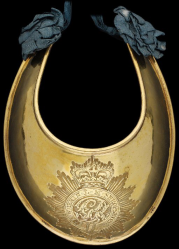 There are also unspecified “uniform items” associated with Major Edward Cludde of this regiment that are listed in the National Army Museum’s inventory, which I have not seen.
There are also unspecified “uniform items” associated with Major Edward Cludde of this regiment that are listed in the National Army Museum’s inventory, which I have not seen.
Ripley and Moodie show a drawing of a gilt, convex button, 18.5 mm in diameter, showing a crowned garter inscribed “Honi Soit” etc, between “Wrekin / Shropshire” and “L M” in serifed capitals, enclosing the Royal cypher.

